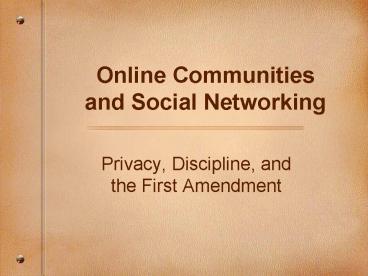Online Communities and Social Networking PowerPoint PPT Presentation
1 / 25
Title: Online Communities and Social Networking
1
Online Communities and Social Networking
- Privacy, Discipline, and the First Amendment
2
What are online communities?
- Online location where a user can create a
profile and build a personal network that him or
her to other users. - MySpace - 85
- Facebook - 7
- Xanga - 1
- Others (Friendster, Yahoo, Piczo, Classmates.com,
Tagged.com, etc.) - 7
3
MySpace
- Social networking website geared toward all
internet users - Loose age restrictions
- Supports creative user profiles
- On August 6, 2006, MySpace reported the one
millionth page was created in the Netherlands
4
- Created in 2004 by Mark Zuckerberg
- Originally intended for college students as a
more closed system based on .edu e-mail address - Now, Facebook is now available to all individuals
with a valid e-mail address
5
Teen Usage of Social Networks
6
Teen Usage of Social Networks
- Girls
- More likely to participate in social networking
than boys - Participation rates increase with age
- Utilize the social networking sites to reinforce
pre-existing relationships
- Boys
- Less likely than girls to participate in social
networking - Like girls, participation rates increase with age
- Utilize sites to flirt and make new friends
7
What are they doing on the sites?
8
Legal Issues from Social Networking
- Privacy
- Discipline
- Safety
- Cyber-Bullying
9
Cyber-bullying
- 39 of teens report having experienced some form
of cyber-bullying.
10
Cyber-bullying (cont.)
- Primary purpose is to spread college gossip
- Terms of Use are similar to other social
networking sites - Not as strictly monitored as MySpace and Facebook
11
Current Issue Online Accountability
Teen Bullying Online - NBC News
12
First Amendment
- Congress shall make no law respecting an
establishment of religion, or prohibiting the
free exercise thereof or abridging the freedom
of speech, or of the press or the right of the
people peaceably to assemble, and to petition the
Government for a redress of grievances.
13
Case Review
- Tinker v. Des Moines Independent Community School
District (1969) - Students do not shed their First Amendment rights
while at public school
14
Case Review
- Bethel School District v. Fraser (1986)
- School officials can prohibit student speech that
is vulgar, lewd, or plainly offensive on-campus
or at a school sponsored event.
15
Case Review
- J.S. v. Bethlehem Area School
- District (2002)
- Online threats are not covered under First
Amendment - If brought on-campus, actions can be punishable
by school administration
16
Case Study
17
Case Review
- Layshock v. Hermitage School
- District (2007)
- Fraser standard does not expand the authority of
schools to punish lewd and profane off-campus
speech.
18
Legal Implications for Educators
- What to consider before taking action
- Is the online infraction a true threat?
- If yes, then the First Amendment privilege does
not apply - Did the incident happen on-campus or was it
brought on-campus? - If yes, then the school can take disciplinary
action (Fraser test)
19
Legal Implications for Educators
- Will the incident disrupt the actions of the
school day? - If yes, then school administrators can prohibit
actions that will cause a material and
substantial disruption (Tinker) - Did the infraction invade the rights of others?
- If yes, then the individual may face charges of
defamation or libel.
20
What Schools Can Do
- Educate teachers on the variety of social
networking sites students are using. - Teach students how to use social networking sites
responsibly. - Encourage parents to become more involved in
their childs online activities. - Create and enforce school-wide internet usage
policies.
21
Conclusion
- Schools can and will adjust to the new
challenges created by students and the
Internet, but not at the expense of the First
Amendment. - Judge Thomas McPhee, 2000
22
References
- Alexander, K. Alexander, M.D. (2005). American
Public School Law (6th edition). Belmont, CA
Thomason West. - Barnes, S. (2004). Issues of attribution and
identification in online social research In M.D.
Johns, S.S. Chen G.J. Hall (2004). Online
Social Research Methods, Issues, Ethics
(pp.203-222). New York Peter Lang. - Berman, P.S. (2007). Law and Society Approaches
to Cyberspace. Burlington, VT Ashgate Publishing
Company. - Buckman, R. (2005). Too much information?
College fear student position on popular Facebook
site could pose security risks. The Wall Street
Journal. December 8, 2005. - Cate, F.H. (1998). The Internet and the First
Amendment Schools and sexually explicit
expression. Bloomington, IN Phi Delta Kappa
Educational Foundation.
23
References
- Creech, K.C. (2003). Electronic Media Law and
Regulation (4th edition). New York Focal Press. - Gillmor, D.M., Barron, J.A., Simon, T.F.
(1998). Mass Communication Law (6th edition).
Belmont, CA Wadsworth Publishing Company - Howard, P.N. Jones, S. (2004). Society Online
The Internet in Context. Thousand Oaks, CA Sage
Publications, Inc. - Hudson, D.L. (2005). Student Online Expression
What do the Internet and MySpace mean for
students First Amendment Rights?. Accessed on
March 1, 2008 at www.firstamendmentcenter.org. - Kelsey, C.M. (2007). Generation MySpace Helping
Your Teen Survive Online Adolescents. New York
Avalon Publishing Group
24
References
- Lash, D. (2005). Site used to aid investigations.
The Daily Collegian. November 10, 2005. - Lenhart, A. (2007). Social Networking Website and
Teens An Overview. Accessed from
http//www.pewinternet.org/PPF/r/198/report_displa
y.asp on March 1, 2008. - Lindsay, C.L. (2005). The College Students Guide
to the Law. Lanham, MA Taylor Trade Publishing - Morgano, A. (2007). MySpace.com and Web Postings
The First Amendment Rights of Public High School
Students. State College, PA The Pennsylvania
State University.
25
References
- Russomanno, J. (2005). Defending the First
Commentary on First Amendment issues and cases.
Mahwah, NJ Lawrence Erlbaum Associates, Inc. - Schwabach, A. (2006). Internet and the Law
Technology, Society, and Compromises. Santa
Barbara, CA ABC-CLIO, Inc. - Spinello, R.A. (2002). Regulating Cyberspace The
Policies and Technologies of Control. Westport,
CT Quorum Books

